Fractional Variability—A Tool to Study Blazar Variability
Abstract
1. Blazar Variability
2. Fractional Variability
3. Multi-Wavelength View of the Fractional Variability
4. Data Sample
5. Systematic Study
5.1. Completeness of Data Sample
5.2. Gaps vs. Averaging
5.3. Further Effects
6. Results
6.1. Mrk 421
6.2. Mrk 501
7. Summary and Discussion
Author Contributions
Funding
Acknowledgments
Conflicts of Interest
References
- Punch, M.; Akerlof, C.W.; Cawley, M.F.; Chantell, M.; Fegan, D.J.; Fennell, S.; Gaidos, J.A.; Hagan, J.; Hillas, A.M.; Jiang, Y.; et al. Detection of TeV photons from the active galaxy Markarian 421. Nature 1992, 358, 477–478. [Google Scholar] [CrossRef]
- Quinn, J.; Akerlof, C.W.; Biller, S.; Buckley, J.; Carter-Lewis, D.A.; Cawley, M.F.; Catanese, M.; Connaughton, V.; Fegan, D.J.; Finley, J.P.; et al. Detection of Gamma Rays with E > 300 GeV from Markarian 501. Astrophys. J. Lett. 1996, 456, L83. [Google Scholar] [CrossRef]
- Abeysekara, A.U.; Archambault, S.; Archer, A.; Benbow, W.; Bird, R.; Buchovecky, M.; Buckley, J.H.; Bugaev, V.; Cardenzana, J.V.; Cerruti, M.; et al. A search for spectral hysteresis and energy-dependent time lags from X-ray and TeV gamma-ray observations of Mrk 421. Astrophys. J. 2017, 834, 2. [Google Scholar] [CrossRef]
- Ahnen, M.L.; Ansoldi, S.; Antonelli, L.A.; Antoranz, P.; Babic, A.; Banerjee, B.; Bangale, P.; Barres de Almeida, U.; Barrio, J.A.; Becerra González, J.; et al. Multiband variability studies and novel broadband SED modeling of Mrk 501 in 2009. Astron. Astrophys. 2017, 603, A31. [Google Scholar] [CrossRef]
- Edelson, R.; Turner, T.J.; Pounds, K.; Vaughan, S.; Markowitz, A.; Marshall, H.; Dobbie, P.; Warwick, R. X-ray spectral variability and rapid variability of the soft X-ray spectrumseyfert 1 galaxies arakelian 564 and ton s180. Astrophys. J. 2002, 568, 610–626. [Google Scholar] [CrossRef]
- Poutanen, J.; Zdziarski, A.A.; Ibragimovet, A. Superorbital variability of X-ray and radio emission of Cyg X-1—II. Dependence of the orbital modulation and spectral hardness on the superorbital phase. Mon. Not. Roy. Astron. Soc. 2008, 389, 1427–1438. [Google Scholar] [CrossRef]
- Vaughan, S.; Edelson, R.; Warwick, R.S.; Uttley, P. On characterizing the variability properties of X-ray light curves from active galaxies. Mon. Not. Roy. Astron. Soc. 2003, 345, 1271–1284. [Google Scholar] [CrossRef]
- Paneque, D.; Baloković, M.; Becerra, P.; Doert, M.; Hughes, G.; Shukla, A.; Tavecchio, F.; Tramacere, A.; Wendel, C.; Noda, K.; et al. Unravelling the complex behaviour of our closest very-high-energy gamma-ray blazars, Mrk421 and Mrk501. in preparation.
- Baloković, M.; Paneque, D.; Madejski, G.; Furniss, A.; Chiang, J.; Ajello, M.; Alexander, D.M.; Barret, D.; Blandford, R.D.; Boggs, S.E.; et al. Multiwavelength Study of Quiescent States of Mrk 421 with Unprecedented Hard X-ray Coverage Provided by NuSTAR in 2013. Astrophys. J. 2016, 819, 156. [Google Scholar] [CrossRef]
- Aleksić, J.; Ansoldi, S.; Antonelli, L.A.; Antoranz, P.; Babic, A.; Bangale, P.; Barres de Almeida, U.; Barrio, J.A.; Becerra González, J.; Bednarek, W.; et al. The 2009 multiwavelength campaign on Mrk 421: Variability and correlation studies. Astron. Astrophys. 2015, 576, A126. [Google Scholar] [CrossRef]
- Ahnen, M.L.; Ansoldi, S.; Antonelli, L.A.; Antoranz, P.; Babic, A.; Banerjee, B.; Bangale, P.; Barres de Almeida, U.; Barrio, J.A.; Becerra González, J.; et al. Long-term multi-wavelength variability and correlation study of Markarian 421 from 2007 to 2009. Astron. Astrophys. 2016, 593, A91. [Google Scholar] [CrossRef]
- Aleksić, J.; Ansoldi, S.; Antonelli, L.A.; Antoranz, P.; Babic, A.; Bangale, P.; Barres de Almeida, U.; Barrio, J.A.; Becerra González, J.; Bednarek, W.; et al. Unprecedented study of the broadband emission of Mrk 421 during flaring activity in March 2010. Astron. Astrophys. 2015, 578, A22. [Google Scholar] [CrossRef]
- Giebels, B.; Dubus, G.; Khélifi, B. Unveiling the X-ray/TeV engine in Mkn 421. Astron. Astrophys. 2007, 462, 29–41. [Google Scholar] [CrossRef]
- Albert, J.; Aliu, E.; Anderhub, H.; Antoranz, P.; Armada, A.; Baixeras, C.; Barrio, J.A.; Bartko, H.; Bastieri, D.; Becker, J.K.; et al. Variable very high energy gamma-ray emission from Markarian 501. Astrophys. J. 2007, 669, 862–883. [Google Scholar] [CrossRef]
- Abdo, A.A.; Ackermann, M.; Ajello, M.; Allafort, A.; Baldini, L.; Ballet, J.; Barbiellini, G.; Baring, M.G.; Bastieri, D.; Bechtol, K.; et al. Insights into the High-Energy Gamma-Ray Emission of Markarian 501 from Extensive Multifrequency Observations in the Fermi Era. Astrophys. J. 2011, 727, 129. [Google Scholar] [CrossRef]
- Aleksić, J.; Ansoldi, S.; Antonelli, L.A.; Antoranz, P.; Babic, A.; Bangale, P.; Barres de Almeida, U.; Barrio, J.A.; Becerra González, J.; Bednarek, W.; et al. Multiwavelength observations of Mrk 501 in 2008. Astron. Astrophys. 2015, 573, A50. [Google Scholar] [CrossRef]
- Furniss, A.; Noda, K.; Boggs, S.; Chiang, J.; Christensen, F.; Craig, W.; Giommi, P.; Hailey, C.; Harisson, F.; Madejski, G.; et al. First NuSTAR Observations of Mrk 501 within a Radio to TeV Multi-Instrument Campaign. Astrophys. J. 2015, 812, 65. [Google Scholar] [CrossRef]
- Richards, J.L.; Max-Moerbeck, W.; Pavlidou, V.; King, O.G.; Pearson, T.J.; Readhead, A.C.S.; Reeves, R.; Shepherd, M.C.; Stevenson, M.A.; Weintraub, L.C.; et al. Blazars in the fermi era: The ovro 40 m telescope monitoring program. Astrophys. J. Suppl. Ser. 2011, 194, 29. [Google Scholar] [CrossRef]
- Krimm, H.A.; Holland, S.T.; Corbet, R.H.D.; Pearlman, A.B.; Romano, P.; Kennea, J.A.; Bloom, J.S.; Barthelmy, S.D.; Baumgartner, W.H.; Cummings, J.R.; et al. The swift/bat hard x-ray transient monitor. Astrophys. J. Suppl. Ser. 2013, 209, 14. [Google Scholar] [CrossRef]
- Stroh, M.C.; Falcone, A.D. Swift X-ray Telescope Monitoring of Fermi-LAT Gamma Ray Sources of Interest. Astrophys. J. Suppl. 2013, 207, 28. [Google Scholar] [CrossRef]
- Thompson, D.J. Fermi: Monitoring the Gamma-Ray Universe. Galaxies 2018, 6, 117. [Google Scholar] [CrossRef]
- Anderhub, H.; Backes, M.; Biland, A.; Boccone, V.; Braun, I.; Bretz, T.; Buß, J.; Cadoux, F.; Commichau, V.; Djambazov, L.; et al. Design and operation of FACT-The first G-APD Cherenkov telescope. J. Instrum. 2013, 8, P06008. [Google Scholar] [CrossRef]
- Shukla, A.; Mannheim, K.; Patel, S.R.; Roy, J.; Chitnis, V.R.; Dorner, D.; Rao, A.R.; Anupama, G.C.; Wendel, C. Short-timescale gamma-Ray Variability in CTA 102. Astrophys. J. Lett. 2018, 854, L26. [Google Scholar] [CrossRef]
- Aleksić, J.; Ansoldi, S.; Antonelli, L.A.; Antoranz, P.; Babic, A.; Bangale, P.; Barrio, J.A.; González, J.B.; Bednarek, W.; Bernardini, E.; et al. Black hole lightning due to particle acceleration at subhorizon scales. Science 2014, 346, 1080. [Google Scholar] [CrossRef] [PubMed]
| 1 | |
| 2 | |
| 3 | |
| 4 | |
| 5 | NASA DOE: Fermi LAT Collaboration |
| 6. |

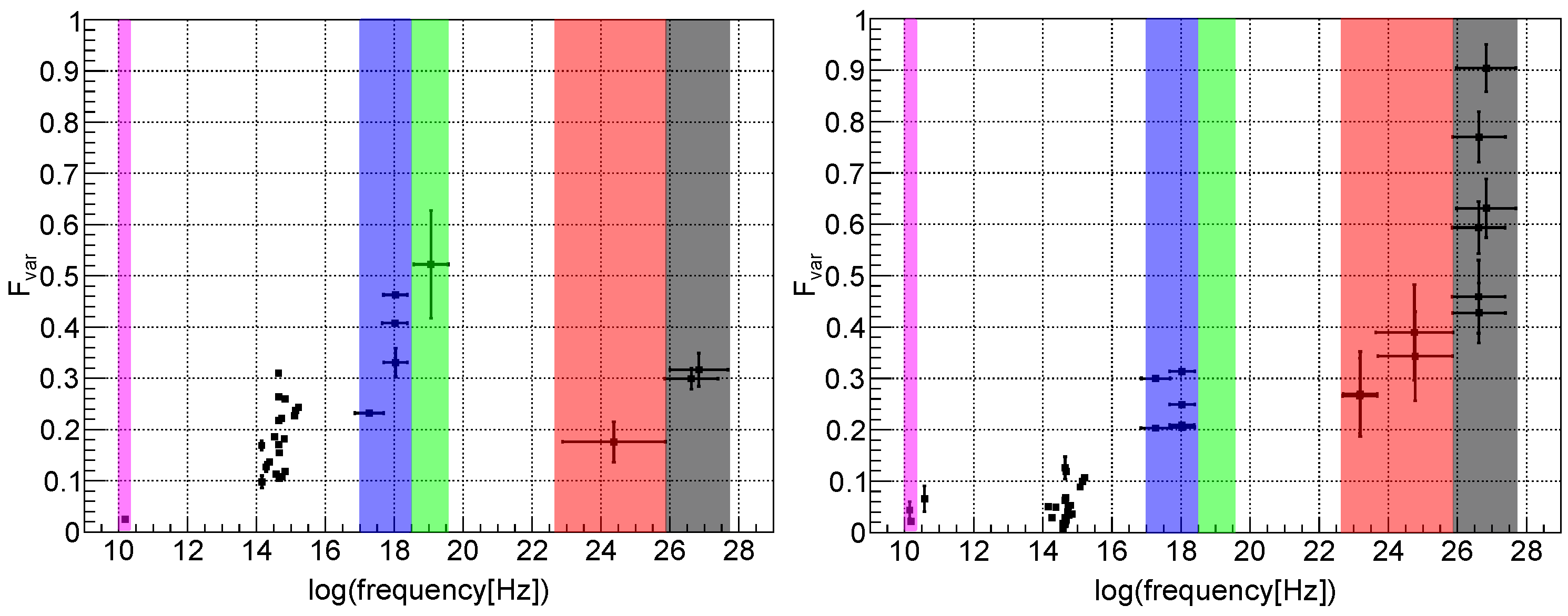
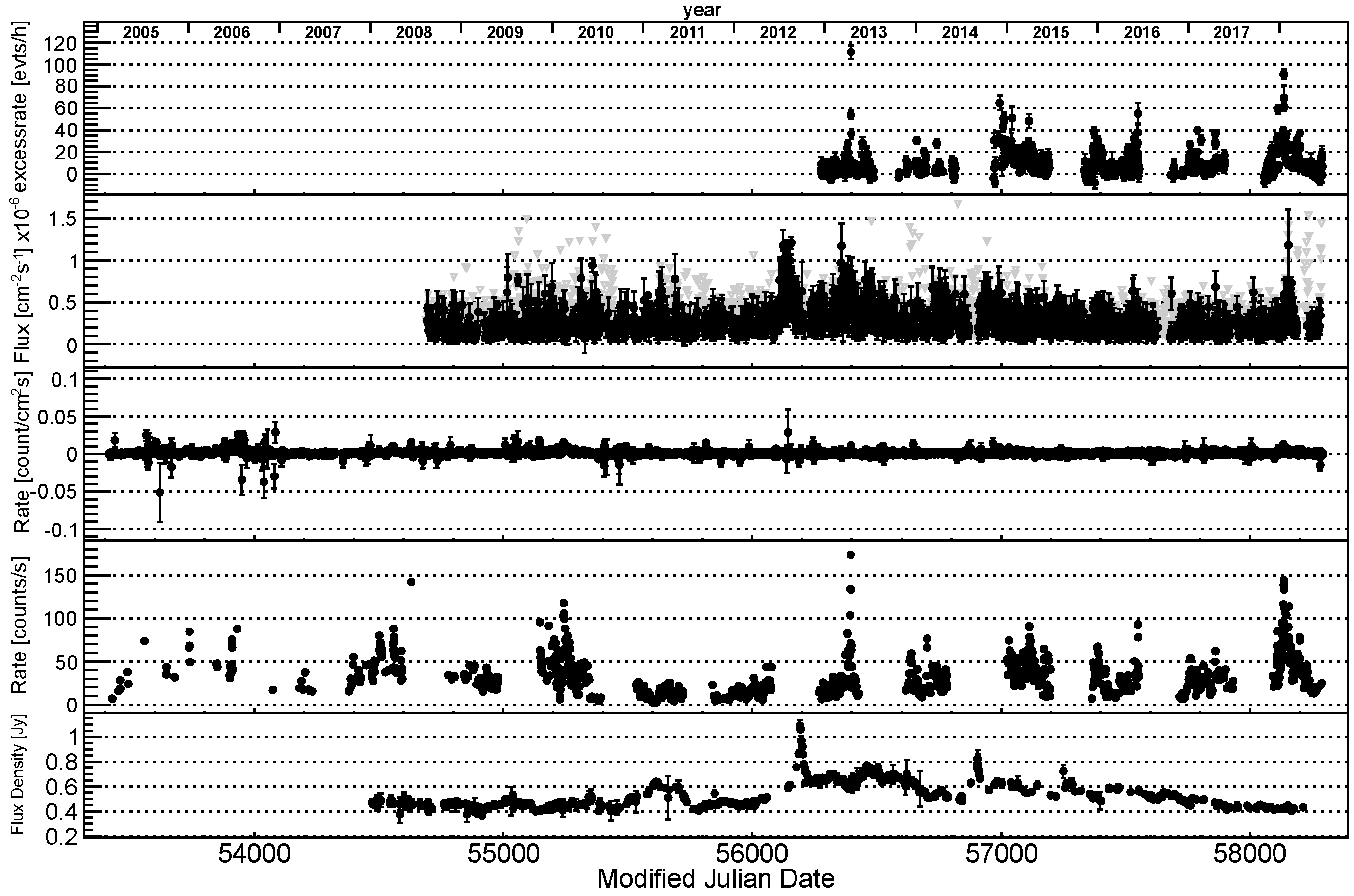
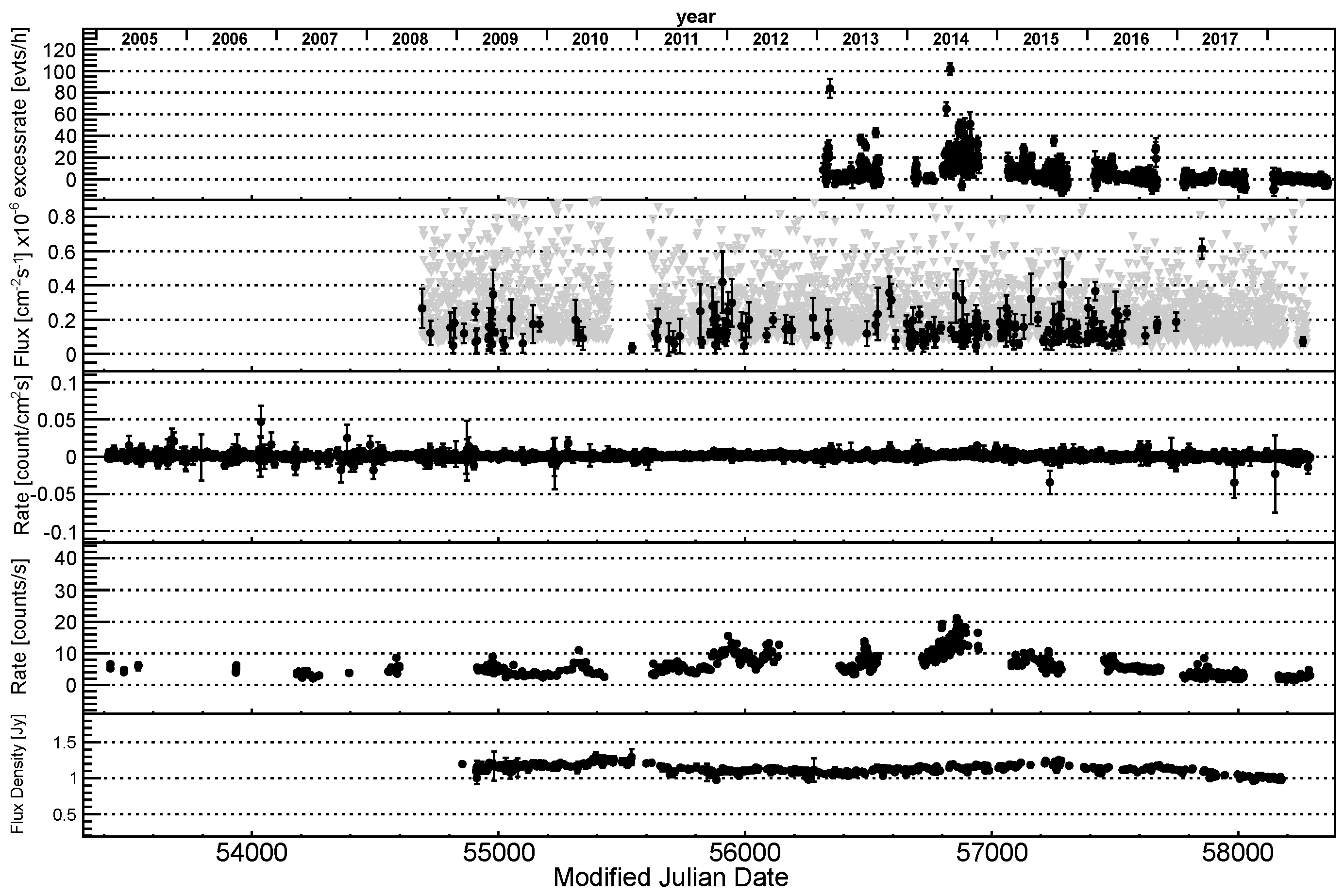
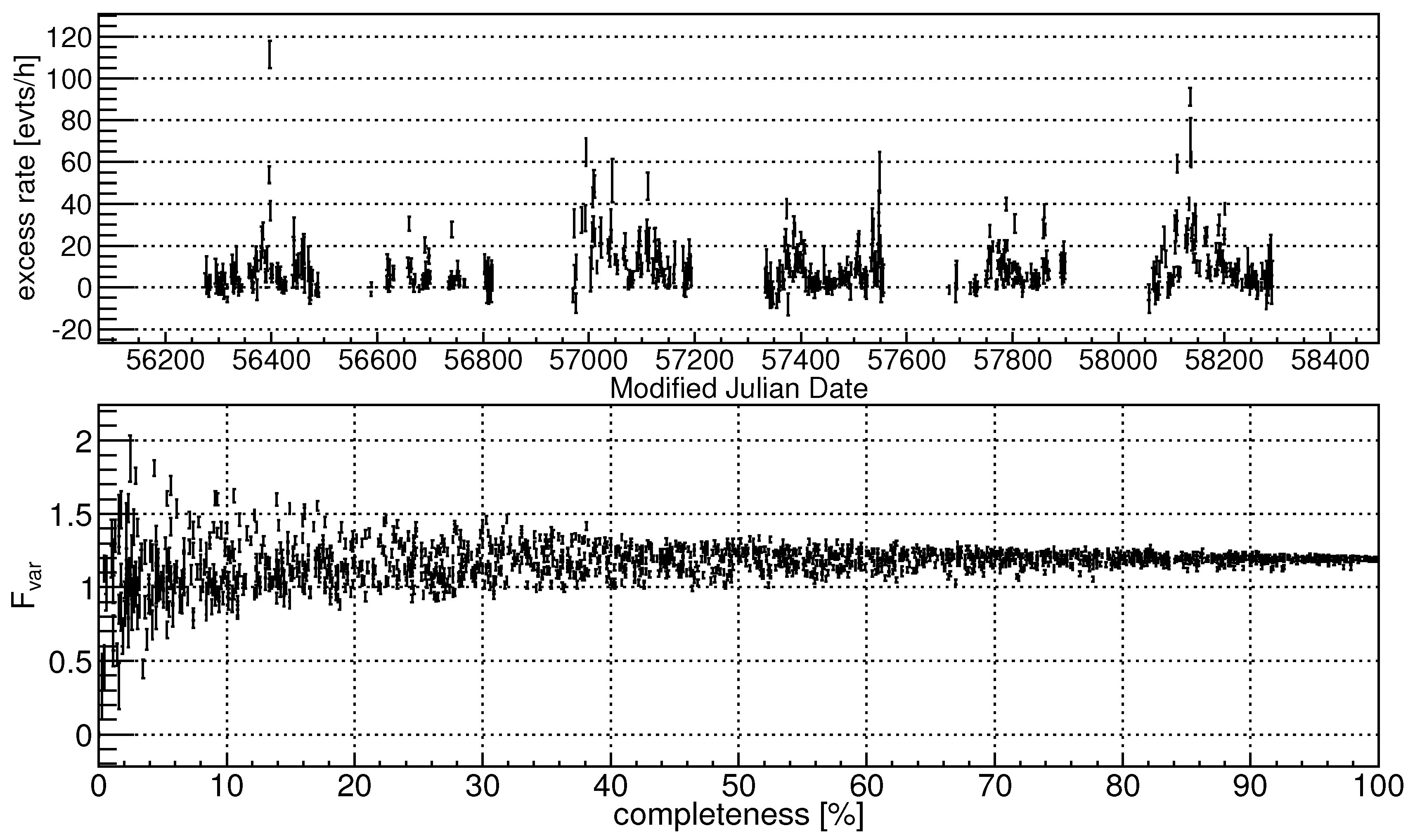
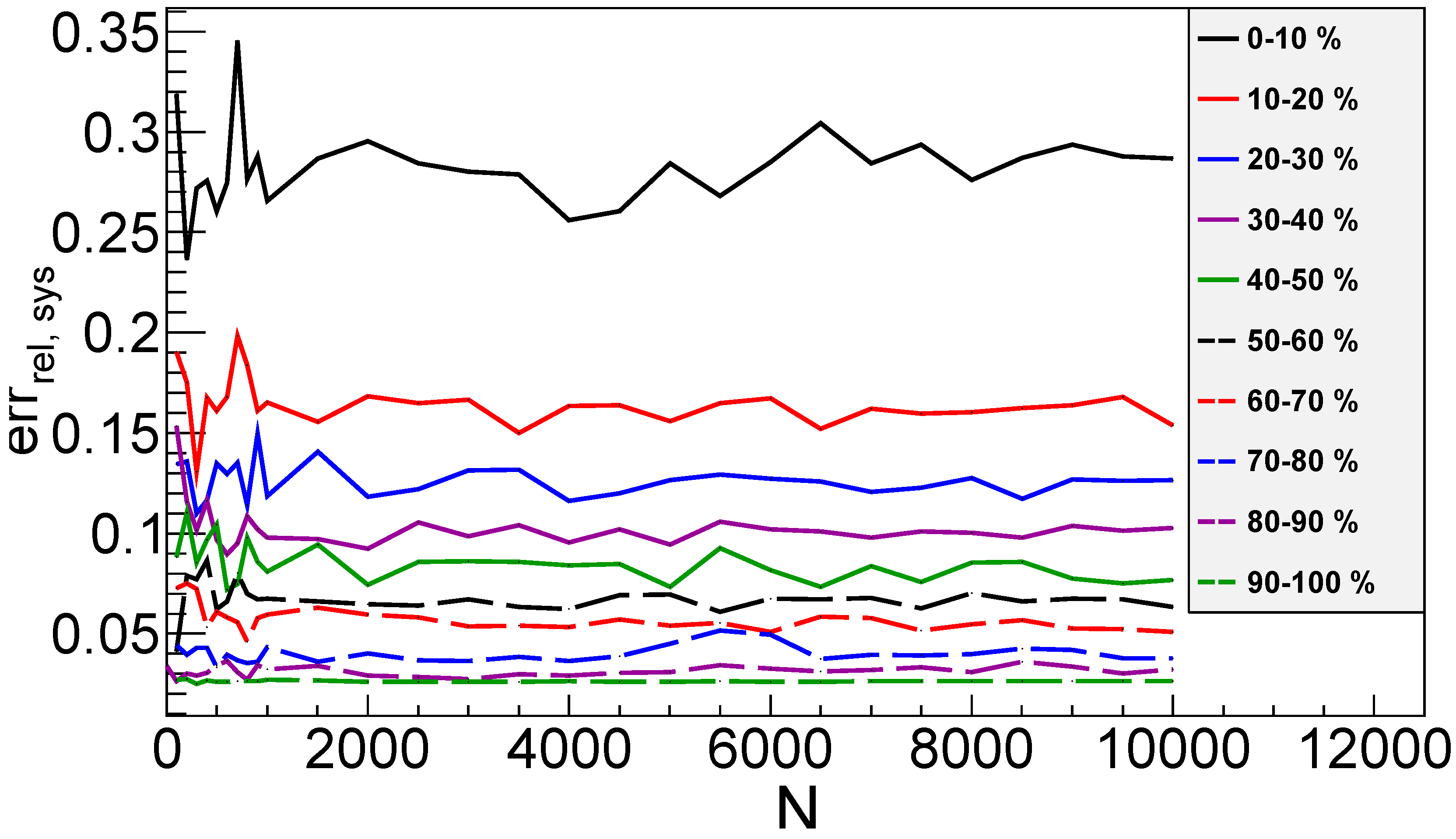
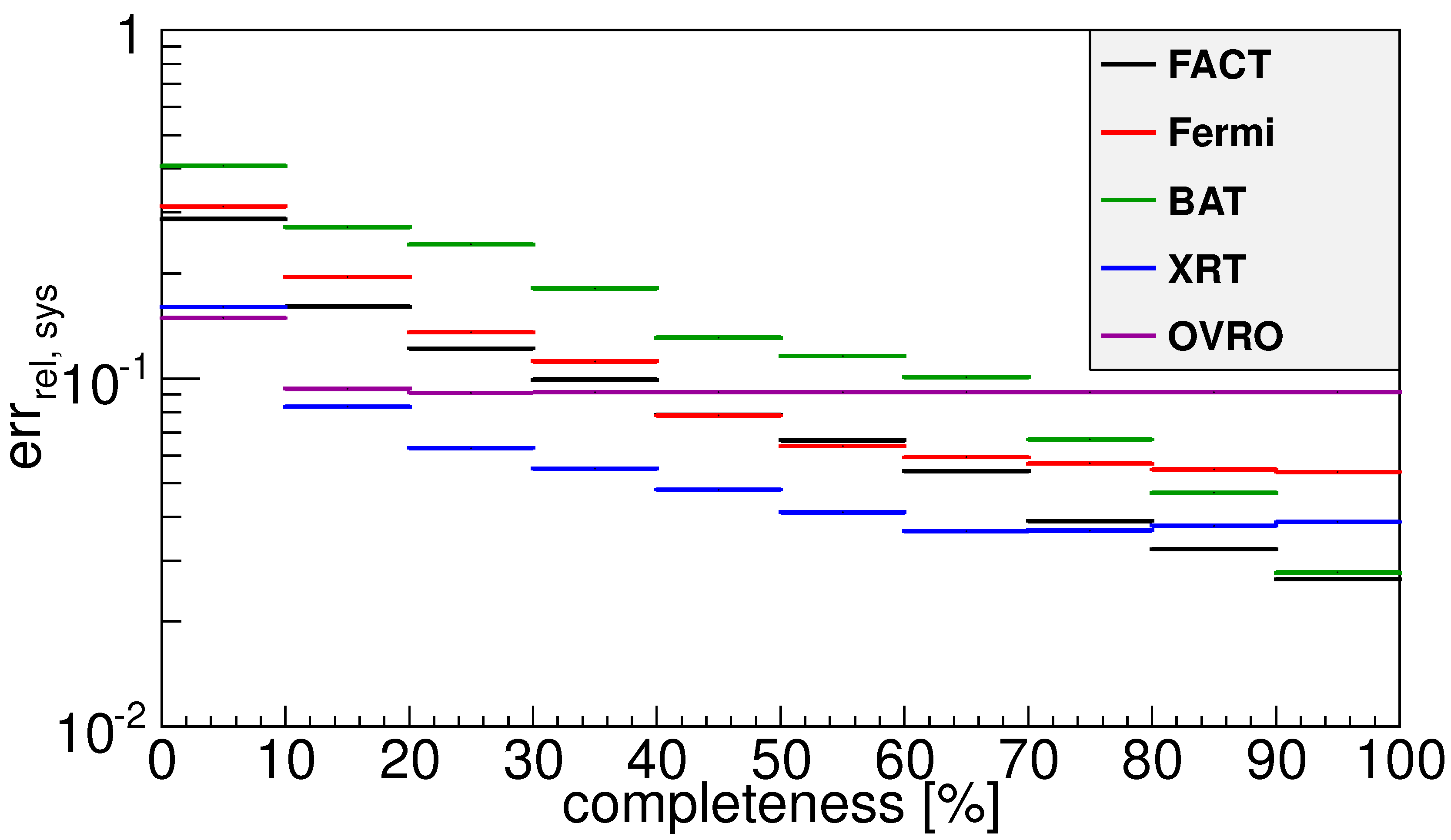
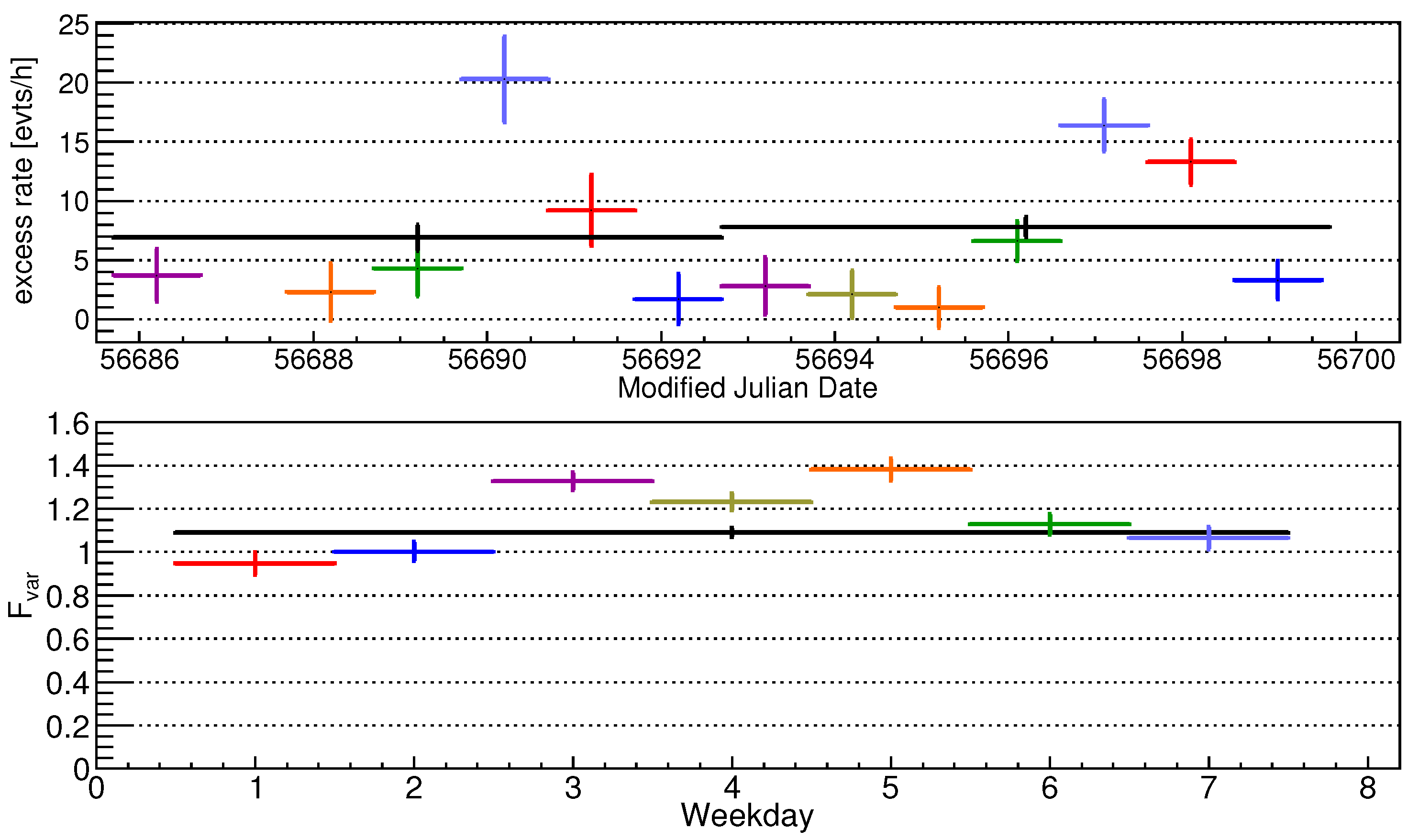
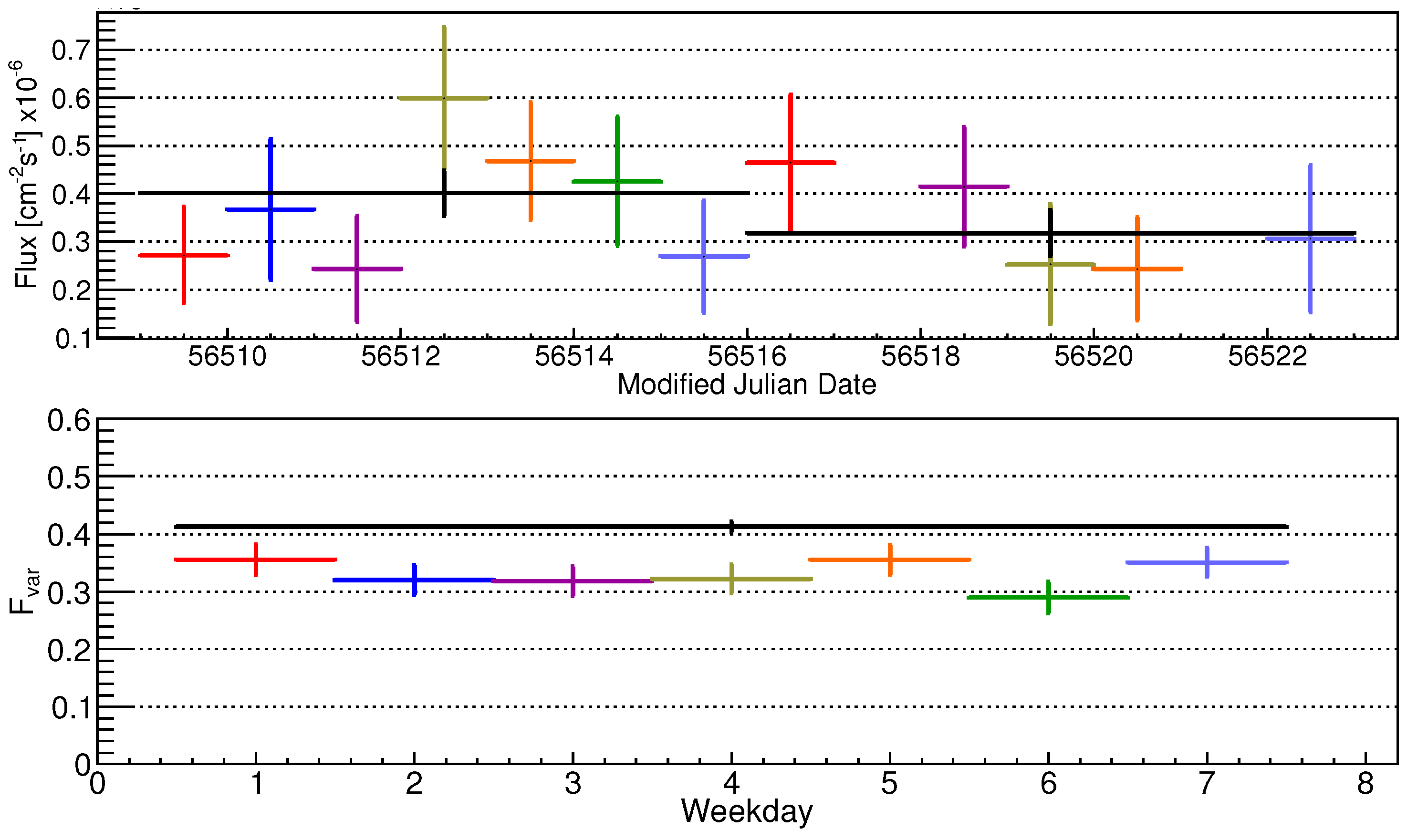
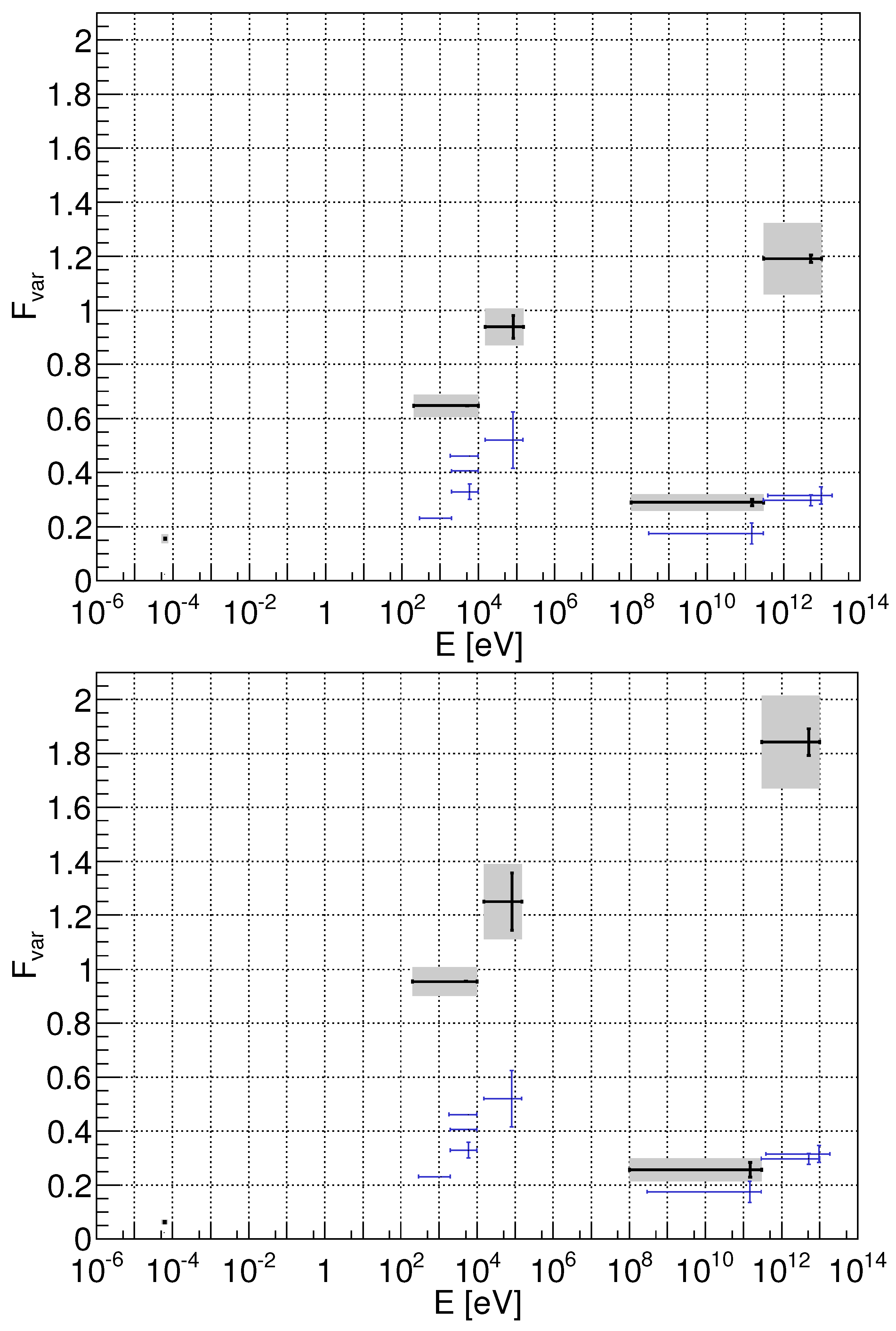
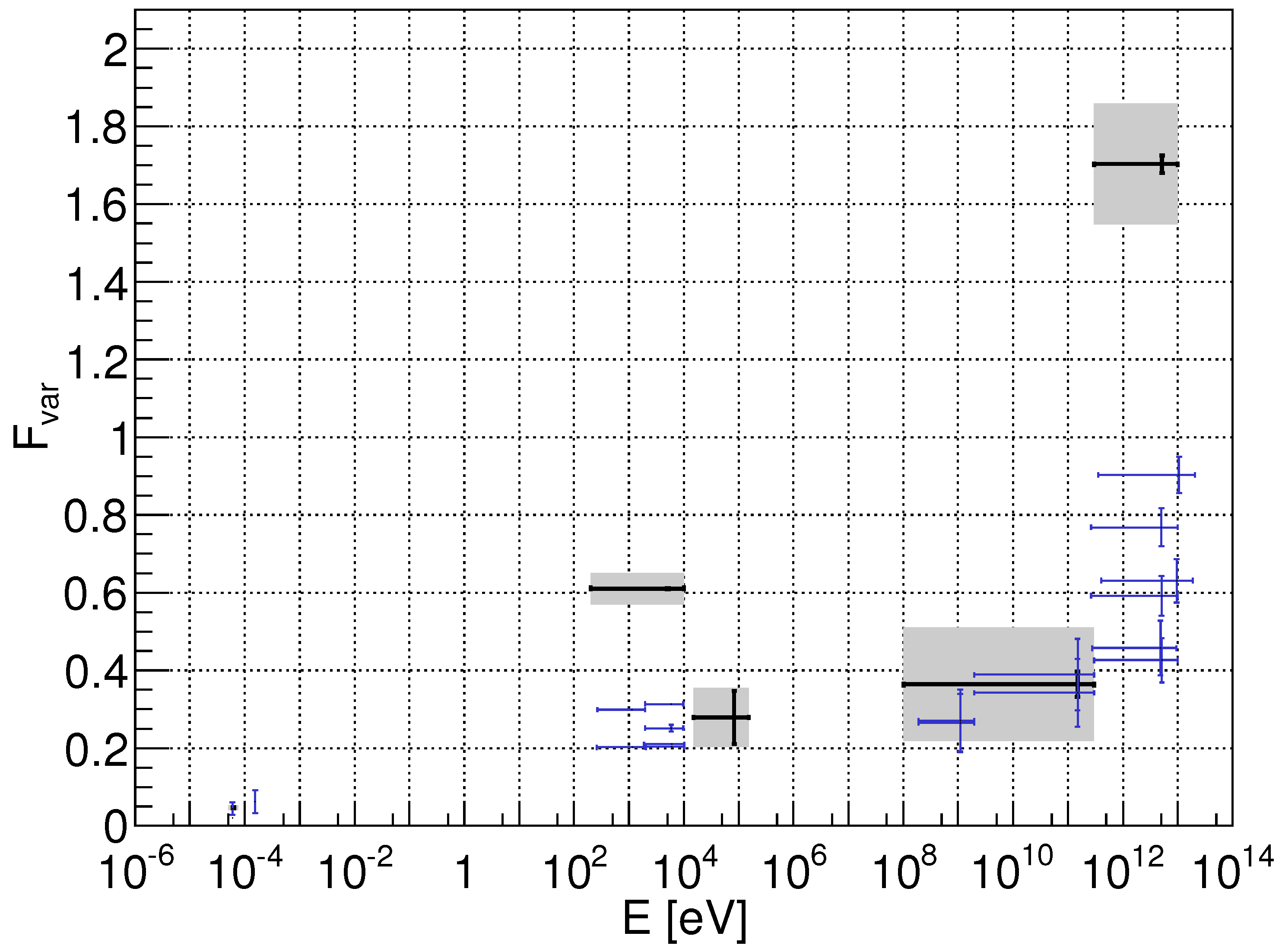
© 2019 by the authors. Licensee MDPI, Basel, Switzerland. This article is an open access article distributed under the terms and conditions of the Creative Commons Attribution (CC BY) license (http://creativecommons.org/licenses/by/4.0/).
Share and Cite
Schleicher, B.; Arbet-Engels, A.; Baack, D.; Balbo, M.; Biland, A.; Blank, M.; Bretz, T.; Bruegge, K.; Bulinski, M.; Buss, J.; et al. Fractional Variability—A Tool to Study Blazar Variability. Galaxies 2019, 7, 62. https://doi.org/10.3390/galaxies7020062
Schleicher B, Arbet-Engels A, Baack D, Balbo M, Biland A, Blank M, Bretz T, Bruegge K, Bulinski M, Buss J, et al. Fractional Variability—A Tool to Study Blazar Variability. Galaxies. 2019; 7(2):62. https://doi.org/10.3390/galaxies7020062
Chicago/Turabian StyleSchleicher, Bernd, Axel Arbet-Engels, Dominik Baack, Matteo Balbo, Adrian Biland, Michael Blank, Thomas Bretz, Kai Bruegge, Michael Bulinski, Jens Buss, and et al. 2019. "Fractional Variability—A Tool to Study Blazar Variability" Galaxies 7, no. 2: 62. https://doi.org/10.3390/galaxies7020062
APA StyleSchleicher, B., Arbet-Engels, A., Baack, D., Balbo, M., Biland, A., Blank, M., Bretz, T., Bruegge, K., Bulinski, M., Buss, J., Doerr, M., Dorner, D., Elsaesser, D., Grischagin, S., Hildebrand, D., Linhoff, L., Mannheim, K., Mueller, S. A., Neise, D., ... Walter, R. (2019). Fractional Variability—A Tool to Study Blazar Variability. Galaxies, 7(2), 62. https://doi.org/10.3390/galaxies7020062





